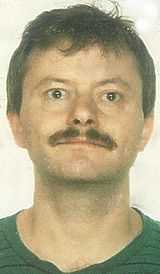Werner Landgraf

| Werner Landgraf | |
|---|---|
| Born |
July 29, 1959 Mainz, Germany |
| Nationality | german |
| Fields | Astrophysics, Cosmology, Fundamental Physics |
| Thesis | Nichtgravitative Kräfte beim Halleyschen Kometen (1988) |
| Doctoral advisor | Hans-Heinrich Voigt |
| Influences |
Brian G. Marsden Hans-Heinrich Voigt Viktor A. Shor Antonín Mrkos Henri Debehogne Bodo Liebe |
| Notable awards |
|
Werner Landgraf is a German astrophysicist born on 29 July 1959 in Mainz.
Life
W. Landgraf studied physics at the University of Siegen in 1977 and was working on his first astronomical projects.[1] His earliest work was very inspired by B.G.Marsden and V.Shor. Two years later, he joined the Department of Astrophysics of University of Göttingen. There he presented his thesis The calculation of atmospheric models and line profiles for the analysis of stellar spectra. He graduated from the university in 1983,[2] and then he worked until 1988 on his dissertation Nongravitational forces of Comet Halley.,[3] under supervision by H.H.Voigt.
In 1986, W. Landgraf received a teaching position at the University of Siegen. In addition to the main lecture about astronomy and astrophysics, he gave lectures also on solar system objects and their motion, Relativity and Cosmology.[4]
Work
W. Landgraf's work mainly concerns the verification and determination of astronomical constants of the reference system, the masses of the planets, non-gravitational forces and the verification of the gravitational law within the solar system. He developed and improved methods for identifying and calculating the orbits of different objects in the solar system. He busied himself in this work with numerous minor planets with emphasis on the near-Earth asteroids, comets, their long term dynamics,[5] and with the observation of small planets and comets.[6] He also developed a method of eliminating systematic errors in positioning brighter comets that resulted in a more accurate prediction of the Halley's Comet.[7] A recalculation of the path of Halley's comet to 2317 BC confirmed that the Greeks had already seen the comet on 466 B.C.[8][9][10]
| Asteroids discovered: 7 | |
|---|---|
| 3683 Baumann | 23. Juni 1987 |
| 4349 Tibúrcio | 5. Juni 1989 |
| 4378 Voigt | 14. Mai 1988 |
| 7696 Liebe | 10. Mai 1988 |
| 9938 Kretlow | 14. Mai 1988 |
| 17412 Kroll | 24. Mai 1988 |
| 29148 Palzer | 10. Mai 1988 |
He discovered different minor planets such as 3683 Baumann, 4378 Voigt (named after Hans-Heinrich Voigt),9938 Kretlow and 4349 Tiburcio[11] at the European Southern Observatory[12]
He examined the properties, individuation and interaction of causets, which each starts from the affirmation that "everything what exists, acts" as its first element and as its sphere of validity successively produces really news, not predetermined by nor contained in and linear independent from old, and that the earliest elements or occurred facts and their aftereffects appear as its internal logical, geometrical, physical properties (namely, the first and the next 1,2,4 ... elements of the same rank, represent its dimensions and corresponding primary natural forces). Applied to our real world, this would suggest that successive events, world points, and their actions already would be an own discrete first dimension and producing force, corresponding to proper time (inclusive a discrete variance and limited vality range of facts and their effects), followed by the similar time; a kinematic extension, and two equivalent curvature-defining geometric extensions. This makes plausible that the dimensions of the world increase proportionally to their elementary units, in a not-localizable manner, very classically and approximately corresponding to a radiation with a wavelength of about the world's size, keeping the biggest part of the world's energy, per each elementary space inclusive at any background or surface one such photon or information and a pressure canceling the gravitational deceleration of expansion [13]
Honours
In 1987, asteroid 3132 Landgraf was named after him.
External links
References
- ↑ http://www.uni-siegen.de/fb7/didaktik/sternwarte/sternwarte200401.pdf Siegen University Observatory
- ↑ http://articles.adsabs.harvard.edu//full/1984MitAG..61..119./0000123.000. html yearly reports Astronomical Institute 1983 (Göttingen)
- ↑ http://gso.gbv.de/DB=2.1/PPNSET ? PPN = 630187614 Nichtgravitative Kräfte beim Halleyschen Kometen (Diss. Göttingen 1988) (pdf)
- ↑ http://articles.adsabs.harvard.edu//full/1991IAUTA..21..187W/0000196.000.html Summary: Report of IAU Commission 20, p.196 center
- ↑ http://minorplanetcenter.net/iau/ECS/MPCArchive/MPCArchive_TBL.html, many MPC's 1979 ... 1987
- ↑ http://minorplanetcenter.net/iau/ECS/MPCArchive/MPCArchive_TBL.html MPC's ... 1991
- ↑ http:// articles.adsabs.harvard.edu//full/1986ESASP.250c.289L/C000291.000.html ESLAB Symposium on the Exploration of Halley's Comet. Volume 3, pp. 289-294
- ↑ http://news.softpedia.com/news/First-Halley-Sighting-Is-200-Years-Older-156358.shtml Halley First Sighting Is 200 Years Older
- ↑ https://archive.org/details/OnTheMotionOfCometHalley'' On the Motion of Halley's_Comet. EP/14.7/6184 ESTEC (1984): ISBN 979-10-90349-07-0 (pdf) Table 9
- ↑ http://adsabs.harvard.edu/abs/1985S% 26W 65L .... 24 .. Comet Halley: orbital elements and Perihelzeiten
- ↑ html Minor Planet Names: Alphabetical List
- ↑ http://www.astro.uni-bonn.de/~pbrosche/aa/ma/ma02-93/ma02-6.pdf
- ↑ Welt und Wirkungsprinzip (2.Aufl. 2010) : ISBN 979-10-90349-02-5 , 979-10-90349-01-8 (pdf)
|